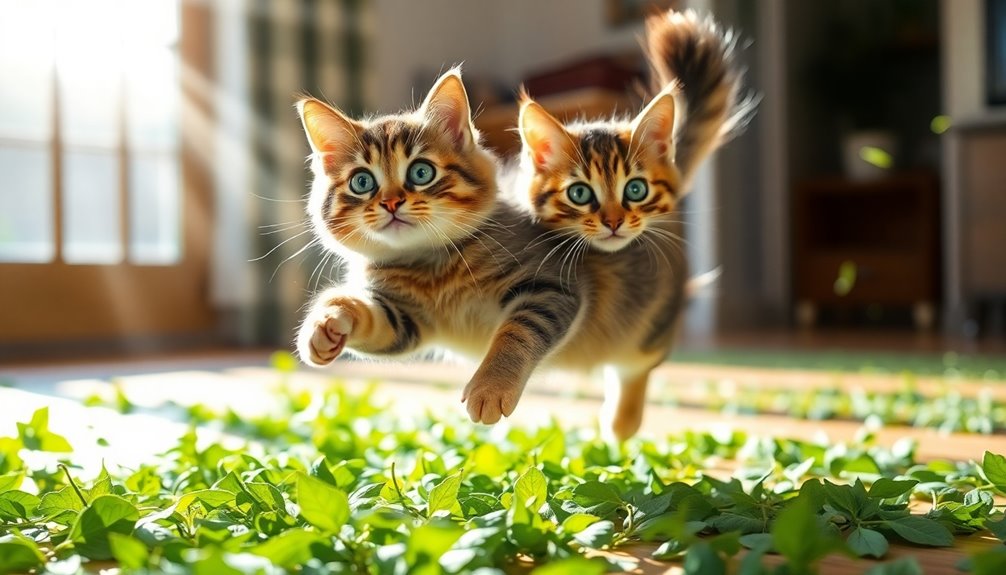If you've ever wondered why cats go crazy for catnip, it's all about the active compound, nepetalactone. When cats sniff or chew catnip, this compound triggers a euphoric reaction, leading to rolling, rubbing, and playful antics. About 80% of cats have a genetic sensitivity to it. The effects usually last about 10 minutes before they need a break. There's a lot more to discover about this fascinating herb and its effects on our feline friends!
Key Takeaways
- Catnip contains nepetalactone, which mimics feline pheromones and triggers euphoric behaviors in cats.
- Approximately 80% of cats respond to catnip due to genetic predisposition.
- Cats exhibit playful behaviors like rolling and rubbing when exposed to catnip.
- The effects last around 10 minutes, after which cats become temporarily immune.
- Nepetalactone also serves as a natural insect repellent, helping protect cats from pests.
What Is Catnip and Its Active Compound
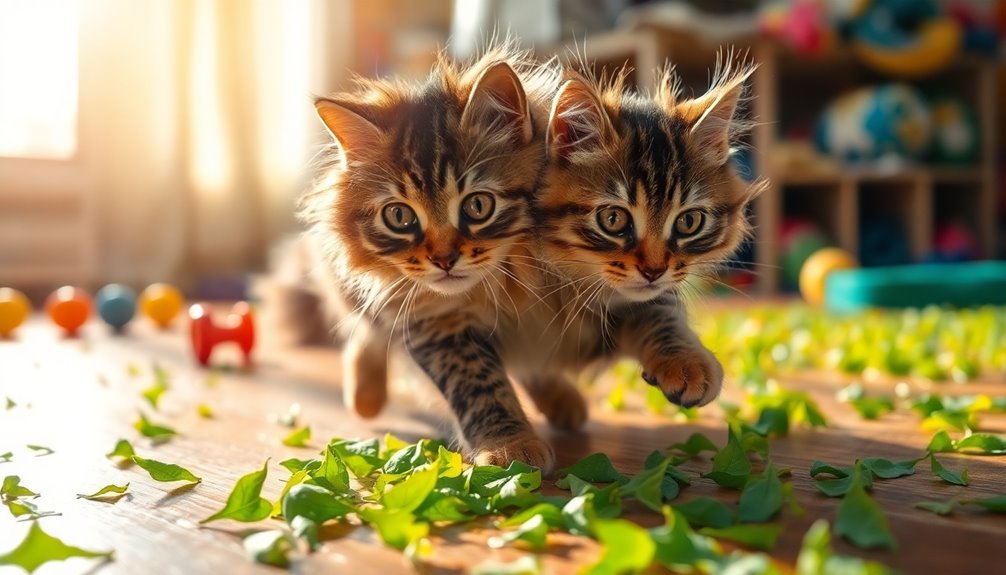
Catnip, or Nepeta cataria, is a fascinating herb from the mint family that captivates many cats.
This plant contains an active compound called nepetalactone, which is responsible for the unique effects it has on feline behavior. When you crush or dry catnip, nepetalactone is released, mimicking certain feline pheromones.
This compound binds to your cat's olfactory receptors, triggering a response in about 80% of cats, which is determined by genetics. The effects usually last around 10 minutes, after which your cat might temporarily become immune to it.
Curiously, nepetalactone doesn't just affect domestic cats; big cats like lions and tigers also react to it, showcasing its appeal across the entire Felidae family.
The Fascinating Feline Response
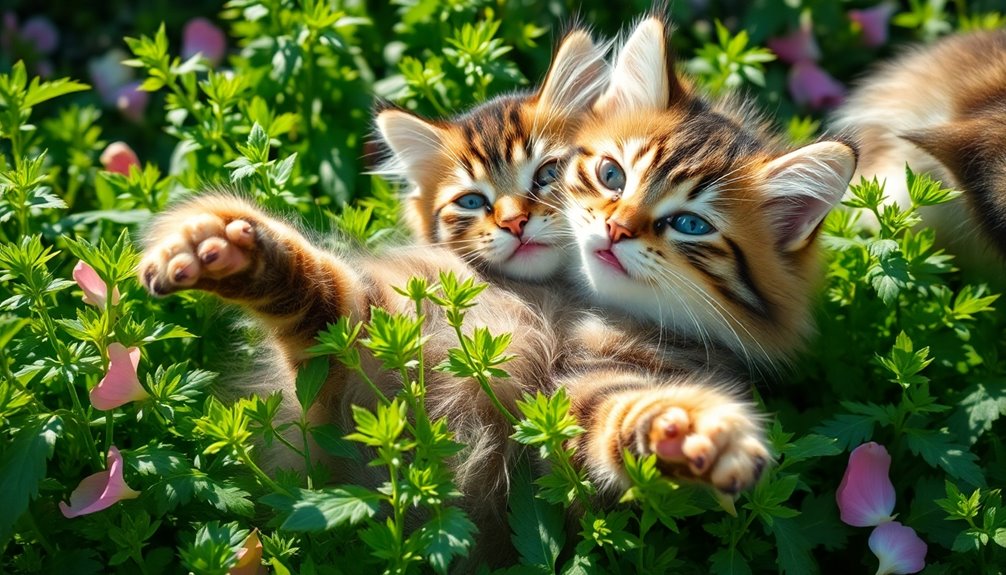
When exposed to catnip, many cats display a mesmerizing array of behaviors that can leave you both amused and intrigued. Approximately 80% of domestic cats respond strongly to catnip due to their genetic predisposition.
The active compound, nepetalactone, binds to their olfactory receptors, triggering a euphoric experience. This reaction activates their opioid systems, increasing beta-endorphin levels and resulting in behaviors like rubbing, rolling, and chewing. Typically, these antics last for about 5 to 15 minutes before your cat becomes temporarily immune to its effects.
Curiously, both domestic cats and larger felines, such as lions and tigers, also react to nepetalactone, showcasing the widespread allure of this fascinating compound across various feline species.
The Role of Nepetalactol in Opioid Activation
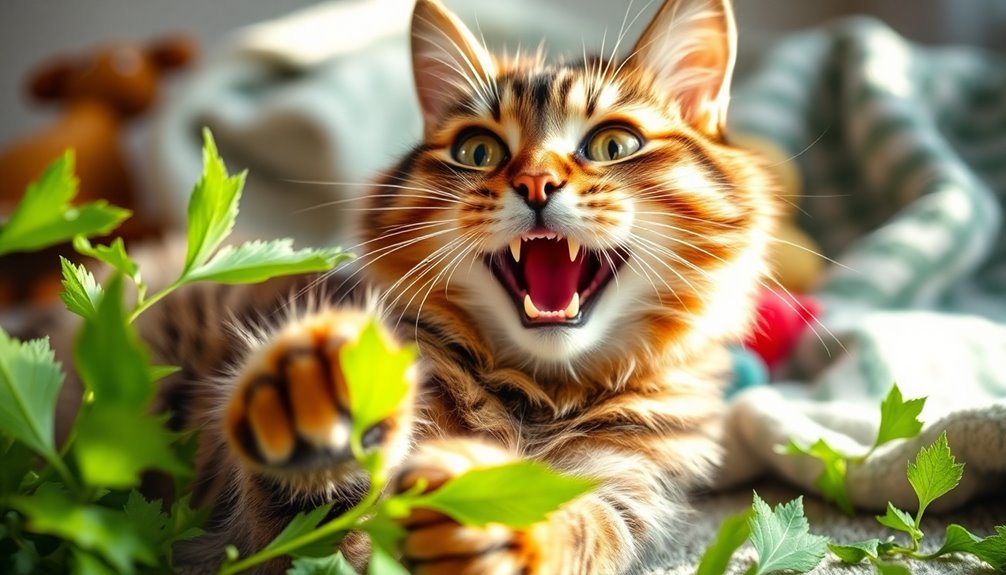
The enchanting effects of catnip are largely attributed to nepetalactol, a compound that plays a significant role in activating the opioid system in cats.
When your feline friend encounters nepetalactol, it triggers the activation of μ-opioid receptors, leading to increased beta-endorphin levels. This interaction induces feelings of pleasure, similar to the euphoric effects of opioids in humans.
You'll notice your cat engaging in playful behaviors like rolling and licking, showcasing its delight. Notably, cats with blocked opioid systems show no interest in nepetalactol, underscoring its essential role.
After about 10 minutes of exposure, cats develop a temporary immunity to these effects, making silver vine leaves an exciting alternative when the catnip craze fades.
Catnip as an Insect Repellent
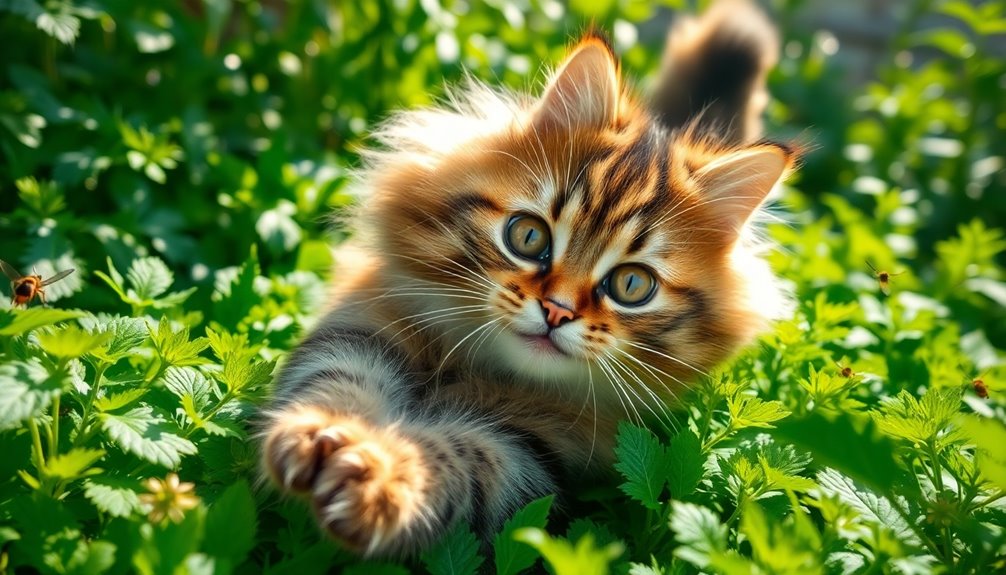
Did you know that catnip can do more than just make your cat feel euphoric?
The active compound, nepetalactone, acts as a natural insect repellent, helping to keep pesky mosquitoes away.
When your cat rolls in catnip, it's not just for fun; they're tapping into an instinctive defense mechanism against biting insects.
Natural Insect Defense Mechanism
While you might think of catnip as a simple plaything for your feline friend, it actually serves a fascinating role as a natural insect repellent. The active compound, nepetalactone, makes catnip an effective insect deterrent, rivaling traditional repellents like DEET.
Research shows that cats treated with nepetalactone attract half the number of mosquitoes compared to those without it. When cats play with catnip or silver vine, the damage to the leaves releases iridoids, enhancing its insect-repelling effects.
This behavior of rolling and rubbing against catnip not only brings your cat joy but also protects them from biting insects. Ultimately, the allure of catnip may have evolved as a defense mechanism against disease-carrying pests, ensuring your cat stays safe and happy.
Euphoria and Protection Link
Although catnip brings joy and excitement to your furry companion, its role as an insect repellent adds another layer of intrigue.
The active compound nepetalactone in catnip works similarly to DEET, effectively repelling mosquitoes. When your cat rolls around in catnip or silver vine, they transfer nepetalactol to their skin, enhancing its insect-repelling properties during grooming.
This euphoric behavior not only delights them but also provides protection from biting insects. Studies indicate that nepetalactone-treated cats attract considerably fewer mosquitoes, showcasing an evolutionary advantage.
The interplay between euphoria and protection links back to their opioid systems, making catnip a fascinating dual-purpose plant that serves both enjoyment and defense against pesky pests.
The Evolutionary Benefits of Catnip
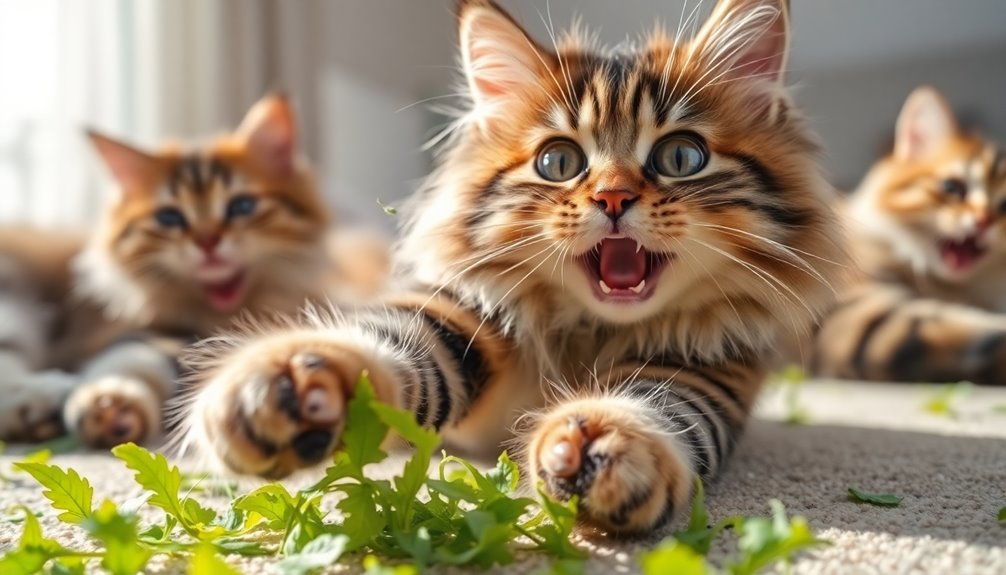
As you watch your cat roll and rub against catnip, it's fascinating to realize that this behavior may have deep-rooted evolutionary benefits.
The leaves of the catnip plant contain nepetalactone, a compound that not only induces euphoria but also serves as an insect repellant. By interacting with catnip, cats spread nepetalactone onto their fur, enhancing their protection against mosquitoes and other biting insects.
This behavior likely evolved under selection pressure, as cats that sought out these plants enjoyed an evolutionary advantage in hunting environments, where stillness makes them vulnerable to bites.
Additionally, the activation of opioid systems during exposure reinforces this behavior, further linking pleasure with survival in the face of insect threats.
Growing and Using Catnip at Home
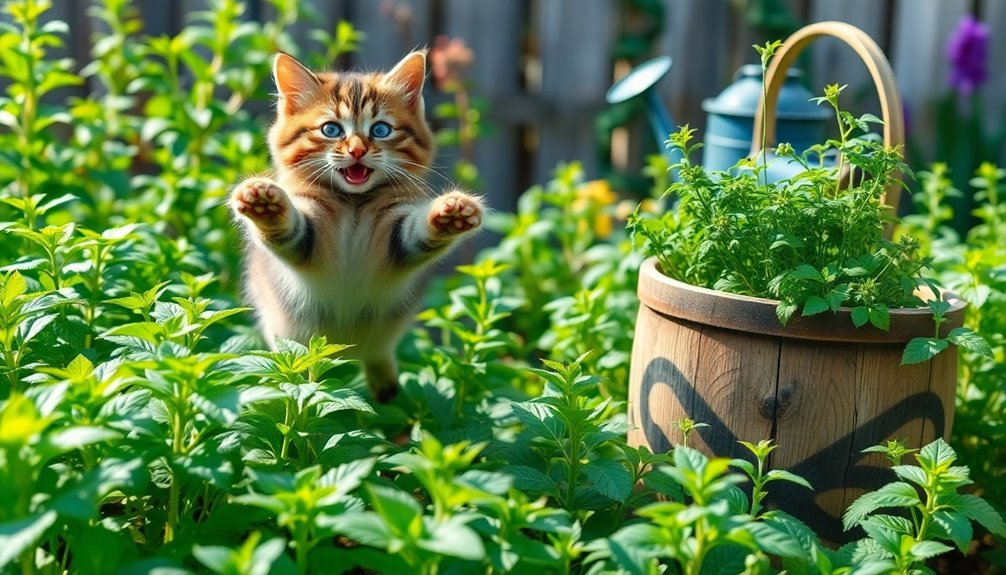
If you're ready to enhance your cat's playtime, growing catnip at home is a great start.
You'll learn how to plant catnip seeds, harvest the leaves, and dry them for maximum potency.
Plus, there are plenty of creative ways to use this delightful herb to keep your feline friend engaged and happy.
Planting Catnip Seeds
When you decide to grow catnip at home, you'll find that it's a rewarding experience that benefits both you and your feline friend.
Start by planting catnip seeds (Nepeta cataria) in well-drained soil during early spring or fall. Cover the seeds lightly and keep the soil moist until germination occurs in about 7 to 10 days.
Catnip thrives in full sun to partial shade, making it adaptable to different garden conditions. Just be mindful, as it can become invasive if not managed.
Once your catnip grows, you can enjoy making dried catnip for toys or sprinkling it for your cat's enrichment, maximizing the effect of nepetalactone, the compound responsible for their playful frenzy.
Harvesting and Drying
To enjoy the full benefits of catnip, you'll want to harvest it at just the right time. Aim to collect your catnip just before it flowers, as this is when nepetalactone levels peak, ensuring maximum potency.
| Step | Description |
|---|---|
| 1. Timing | Harvest before flowering for best results. |
| 2. Cutting | Use sharp scissors to snip stems. |
| 3. Bundling | Hang small bunches upside down. |
| 4. Drying | Place in a dark, dry, ventilated area. |
| 5. Storage | Crumble and store in airtight containers. |
After drying, you can easily crumble the leaves and flowers for cat toys or treats, preserving their aromatic properties for your feline friends!
Creative Usage Ideas
While growing catnip at home can be a rewarding experience, its creative uses extend far beyond just having a plant in your garden.
You can enhance your indoor cats' playful behaviors by mixing dried catnip and silver vine into paper pouches. These pouches can then be placed in their toys or sprinkled on scratching posts, encouraging rolling and rubbing.
To keep the excitement fresh, grow multiple catnip plants, ensuring a continuous supply since cats can become temporarily immune to nepetalactol's effects after repeated exposure.
Additionally, consider brewing fresh catnip into a calming tea for yourself. This way, you'll not only create a stimulating environment for your furry friends but also enjoy the soothing benefits of this delightful herb!
Fun Facts About Catnip and Felines
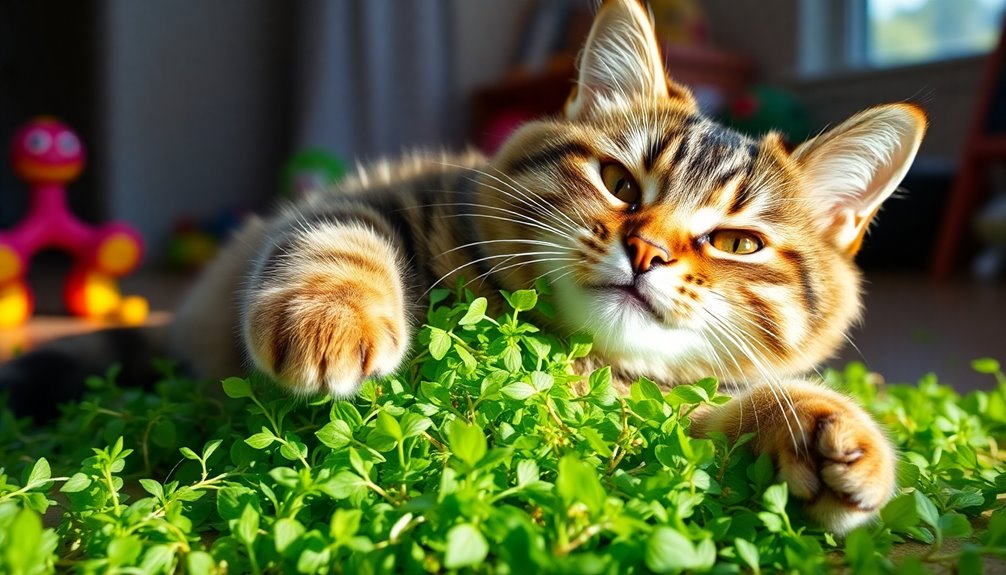
Catnip isn't just a fun treat for your feline friend; it's a fascinating plant with unique effects on cats. Did you know about these intriguing facts?
| Fact | Description | Impact on Cats |
|---|---|---|
| Genetic Variation | About 80% of cats respond to catnip (Nepeta cataria). | Determines susceptibility |
| Active Compound | Nepetalactone mimics pheromones when the plant is crushed. | Triggers a feline high |
| Duration of Effect | Cats typically experience euphoria for about 10 minutes. | Afterward, they become immune |
Not every feline species gets a kick from catnip; dogs and mice don't respond to nepetalactone. So, when your cat goes crazy for catnip, you're witnessing a genetic gift!
Frequently Asked Questions
Why Does My Cat Go Crazy When I Give Him Catnip?
When you give your cat catnip, it reacts because of a compound called nepetalactone.
This substance triggers olfactory receptors in their nose, mimicking pheromones. As a result, you'll see your cat rubbing, rolling, and playing energetically.
These behaviors stem from a pleasurable increase in beta-endorphins, similar to a natural high.
Why Did Cats Evolve to Like Catnip?
Imagine watching your cat roll blissfully in a patch of catnip, completely in the zone.
Cats likely evolved to enjoy catnip as a way to fend off biting insects while they hunted. The chemical nepetalactone triggers pleasure responses, enhancing their hunting skills.
Since about 80% of domestic cats carry this trait, it suggests that enjoying catnip provides an evolutionary advantage, helping them to thrive in the wild while also having fun.
Why Do Cats Get Aggressive After Catnip?
When cats consume catnip, the nepetalactone triggers a euphoric response, which can lead to overstimulation and hyperactivity.
You might notice your cat rolling, rubbing, or even becoming aggressive due to this intense reaction.
About 80% of cats are genetically predisposed to such behaviors, with unaltered adults typically exhibiting stronger responses.
These effects last only 5 to 15 minutes, after which your cat may feel temporarily immune to catnip's allure.
What Do Cats Go Crazy for Besides Catnip?
Just as Odysseus was lured by enchanting sirens, your cat's drawn to other irresistible plants besides catnip.
Silver vine, valerian root, and certain lemongrasses can trigger euphoric responses, making your feline roll and rub in delight.
Even Tatarian honeysuckle can spark their interest.
With 50-75% of cats reacting to these botanical wonders, you might find a new favorite for your furry friend, one that keeps their playful spirit alive.
Conclusion
In a world where cats rule the roost, catnip's their secret weapon for chaos! Picture it: your feline overlord rolling in a green frenzy, plotting world domination one pounce at a time. It's a hilarious spectacle, really. As they uncover their wild side, you can't help but chuckle at their antics. So, next time you toss some catnip their way, remember—you're not just a cat owner; you're an unwitting accomplice in their fluffy little rebellion!
